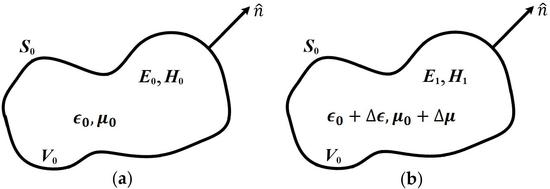A High-Sensitivity Microfluidic Sensor Based on a Substrate Integrated Waveguide Re-Entrant Cavity for Complex Permittivity Measurement of Liquids
Abstract
:1. Introduction
2. Working Principle
2.1. Cavity Perturbation Theory
2.2. Equivalent Circuit Model of Re-Entrant Cavity
3. Sensor Design
3.1. Square SIW Re-Entrant Cavity Resonator Design
3.2. Microfluidic Subsystem Design
4. Complex Permittivity Predictive Model Setup
5. Fabrication and Measurement
5.1. Sensor Fabrication and Measurement Setup
5.2. Complex Permittivity Measurement of Pure Liquids
5.3. Binary Liquid Mixture Measurement
6. Discussion
7. Conclusions
Author Contributions
Funding
Acknowledgments
Conflicts of Interest
References
- Gregory, A.P.; Clarke, R.N. A review of RF and microwave techniques for dielectric measurements on polar liquids. IEEE Trans. Dielectr. Electr. Insul. 2006, 13, 727–743. [Google Scholar] [CrossRef]
- Joshi, K.K.; Pollard, R.D. Sensitivity analysis and experimental investigation of microstrip resonator technique for the in-process moisture/permittivity measurement of petrochemicals and emulsions of crude oil and water. In Proceedings of the 2006 IEEE MTT-S International Microwave Symposium Digest, San Francisco, CA, USA, 11–16 June 2006; pp. 1634–1637. [Google Scholar] [CrossRef]
- Nigmatullin, R.R.; Arbuzov, A.A.; Nelson, S.O.; Trabelsi, S. Dielectric relaxation in complex systems: Quality sensing and dielectric properties of honeydew melons from 10 MHz to 1.8 GHz. J. Instrum. 2006, 1, P10002. [Google Scholar] [CrossRef]
- Kent, M.; Knöchel, R.; Daschner, F.; Schimmer, O.; Oehlenschläger, J.; Mierke-Klemeyer, S.; Kroeger, M.; Barr, U.-K.; Floberg, P.; Tejada, M.; et al. Intangible but not intractable: The prediction of fish ‘quality’ variables using dielectric spectroscopy. Meas. Sci. Technol. 2007, 18, 1029–1037. [Google Scholar] [CrossRef]
- Vélez, P.; Su, L.; Grenier, K.; Mata-Contreras, J.; Dubuc, D.; Martín, F. Microwave Microfluidic Sensor Based on a Microstrip Splitter/Combiner Configuration and Split Ring Resonators (SRRs) for Dielectric Characterization of Liquids. IEEE Sens. J. 2017, 17, 6589–6598. [Google Scholar] [CrossRef]
- Salim, A.; Lim, S. Complementary Split-Ring Resonator-Loaded Microfluidic Ethanol Chemical Sensor. Sensors 2016, 16, 1802. [Google Scholar] [CrossRef] [PubMed]
- Alahnomi, R.A.; Zakaria, Z.; Ruslan, E.; Rashid, S.R.A.; Bahar, A.A.M. High-Q Sensor Based on Symmetrical Split Ring Resonator with Spurlines for Solids Material Detection. IEEE Sens. J. 2017, 17, 2766–2775. [Google Scholar] [CrossRef]
- Kik, A. Complex Permittivity Measurement Using a Ridged Waveguide Cavity and the Perturbation Method. IEEE Trans. Microw. Theory Technol. 2016, 64, 3878–3886. [Google Scholar] [CrossRef]
- Jha, A.K.; Akhtar, M.J. A generalized rectangular cavity approach for determination of complex permittivity of materials. IEEE Trans. Instrum. Meas. 2014, 63, 2632–2641. [Google Scholar] [CrossRef]
- Yoo, M.; Kim, H.K.; Lim, S. Electromagnetic-based ethanol chemical sensor using metamaterial absorber. Sens. Actuators B Chem. 2016, 222, 173–180. [Google Scholar] [CrossRef]
- Liu, W.; Sun, H.; Xu, L. A Microwave Method for Dielectric Characterization Measurement of Small Liquids Using a Metamaterial-Based Sensor. Sensors 2018, 18, 1438. [Google Scholar] [CrossRef] [PubMed]
- Chretiennot, T.; Dubuc, D.; Grenier, K. A microwave and microfluidic planar resonator for efficient and accurate complex permittivity characterization of aqueous solutions. IEEE Trans. Microw Theory Technol. 2013, 61, 972–978. [Google Scholar] [CrossRef]
- Liu, C.; Pu, Y. A microstrip resonator with slotted ground plane for complex permittivity measurements of liquids. IEEE Microw. Wirel. Compon. Lett. 2008, 18, 257–259. [Google Scholar] [CrossRef]
- Yasin, A.; Rehman, F.; Naeem, U.; Khan, S.A.; Shafique, M.F. Top loaded TM01δ mode cylindrical dielectric resonator for complex permittivity characterization of liquids. Radioengineering 2016, 25, 714–720. [Google Scholar] [CrossRef]
- Baker-Jarvis, J.; Riddle, B.F. Dielectric Measurements Using a Reentrant Cavity: Mode-Matching Analysis; NIST Technical Notes 1384; Commerce Department, National Institute of Standards and Technology (NIST): Gaithersburg, MD, USA, 1996. [Google Scholar]
- Xi, W.; Tinga, W.R.; Voss, W.A.G.; Tian, B.Q. New Results for Coaxial Re-Entrant Cavity with Partially Dielectric Filled Gap. IEEE Trans. Microw. Theory Technol. 1992, 40, 747–753. [Google Scholar] [CrossRef]
- Krupka, J.; Geyer, R.G.; Baker-Jarvis, J.; Ceremuga, J. Measurements of the complex permittivity of microwave circuit board substrates using split dielectric resonator and reentrant cavity techniques. In Proceedings of the Seventh International Conference on Dielectric Materials, Measurements and Applications, Bath, UK, 23–26 September 1996; pp. 21–24. [Google Scholar]
- Chen, X.P.; Wu, K. Substrate Integrated Waveguide Filter: Basic Design Rules and Fundamental Structure Features. IEEE Microw. Mag. 2014, 15, 108–116. [Google Scholar] [CrossRef]
- Chen, X.P.; Wu, K. Substrate Integrated Waveguide Filter: Practical Aspects and Design Considerations. IEEE Microw. Mag. 2014, 15, 75–83. [Google Scholar] [CrossRef]
- Sahu, A.; Devabhaktuni, V.K.; Mishra, R.K.; Aaen, P.H. Recent advances in theory and applications of substrate-integrated waveguides: A review. Int. J. RF Microw. Comput. Aided Eng. 2016, 26, 129–145. [Google Scholar] [CrossRef]
- Germain, S.; Deslandes, D.; Wu, K. Development of substrate integrated waveguide power dividers. In Proceedings of the CCECE 2003—Canadian Conference on Electrical and Computer Engineering, Montreal, QC, Canada, 4–7 May 2003; pp. 1921–1924. [Google Scholar] [CrossRef]
- Joshi, H.; Sigmarsson, H.H.; Moon, S.; Peroulis, D.; Chappell, W.J. High-Q fully reconfigurable tunable bandpass filter. IEEE Trans. Microw. Theory Technol. 2009, 57, 3525–3533. [Google Scholar] [CrossRef]
- Liu, X.G.; Katehi, L.P.; Chappell, W.J.; Peroulis, D. High-Q tunable microwave cavity resonators and filters using SOI-based RF MEMS tuners. J. Microelectromech. Syst. 2010, 19, 774–784. [Google Scholar] [CrossRef]
- Saeedi, S.; Lee, J.; Sigmarsson, H.H. Tunable, high-Q, substrate integrated, evanescent-mode cavity bandpass-bandstop filter cascade. IEEE Microw. Wirel. Compon. Lett. 2016, 26, 240–242. [Google Scholar] [CrossRef]
- Saeed, K.; Pollard, R.D.; Hunter, I.C. Substrate integrated waveguide cavity resonators for complex permittivity characterization of materials. IEEE Trans. Microw. Theory Technol. 2008, 56, 2340–2347. [Google Scholar] [CrossRef]
- Whitesides, G.M. The origins and the future of microfluidics. Nature 2006, 442, 368–373. [Google Scholar] [CrossRef] [PubMed]
- Pozar, D.M. Microwave Engineering, 3rd ed.; John Wiley & Sons: New York, NY, USA, 2005. [Google Scholar]
- Gao, C.; Wei, T.; Duewer, F.; Lu, Y.; Xiang, X. High spatial resolution quantitative microwave impedance microscopy by a scanning tip microwave near-field microscope. Appl. Phys. Lett. 1997, 71, 1872–1874. [Google Scholar] [CrossRef]
- Fujisawa, K. General treatment of klystron resonant cavities. IRE Trans. Microw. Theory Technol. 1958, 6, 344–358. [Google Scholar] [CrossRef]
- Le Floch, J.-M.; Fan, Y.; Aubourg, M.; Cros, D.; Carvalho, N.C.; Shan, Q.; Bourhill, J.; Ivanov, E.N.; Humbert, G.; Madrangeas, V.; et al. Rigorous analysis of highly tunable cylindrical transverse magnetic mode re-entrant cavities. Rev. Sci. Instrum. 2013, 84, 125114. [Google Scholar] [CrossRef] [PubMed] [Green Version]
- Barroso, J.J.; Castro, P.J.; Neto, J.P.L.; Aguiar, O.D. Analysis and simulation of re-entrant cylindrical cavities. Int. J. Infrared Millim. Waves 2005, 26, 1071–1083. [Google Scholar] [CrossRef]
- Deslandes, D.; Wu, K. Design consideration and performance analysis of substrate integrated waveguide components. In Proceedings of the 32nd European Microwave Conference, Milan, Italy, 23–26 September 2002. [Google Scholar] [CrossRef]
- Giordano, M.; Momo, F.; Sotgiu, A. On the design of a re-entrant square cavity as resonator for low-frequency ESR spectroscopy. J. Phys. E Sci. Instrum. 1983, 16, 774–779. [Google Scholar] [CrossRef]
- Hayes, G.J.; So, J.H.; Qusba, A.; Dickey, M.D.; Lazzi, G. Flexible Liquid Metal Alloy (EGaIn) Microstrip Patch Antenna. IEEE Trans. Antennas Propag. 2012, 60, 2151–2156. [Google Scholar] [CrossRef]
- Gregory, A.P.; Clarke, R.N. Tables of the Complex Permittivity of Dielectric Reference Liquids Up to 5 GHz; NPL Report MAT 23; CETM: Teddington, UK, 2012. [Google Scholar]
- Buckley, F.; Maryott, A.A. Tables of Dielectric Dispersion Data for Pure Liquids and Dilute Solutions; U.S. Department of Commerce, National Bureau of Standards: Gaithersburg, MD, USA, 1958. [Google Scholar]
- Tuncer, E.; Gubanski, S.M.; Nettelblad, B. Dielectric relaxation in dielectric mixtures: Application of the finite element method and its comparison with dielectric mixture formulas. J. Appl. Phys. 2001, 89, 8092–8100. [Google Scholar] [CrossRef]
- Koirala, G.R.; Dhakal, R.; Kim, E.-S.; Yao, Z.; Kim, N.-Y. Radio Frequency Detection and Characterization of Water-Ethanol Solution through Spiral-Coupled Passive Micro-Resonator Sensor. Sensors 2018, 18, 1075. [Google Scholar] [CrossRef] [PubMed]
- Chudpooti, N.; Silavwe, E.; Akkaraekthalin, P.; Robertson, I.D.; Somjit, N. Nano-Fluidic Millimeter-Wave Lab-on-a-Waveguide Sensor for Liquid-Mixture Characterization. IEEE Sens. J. 2018, 18, 157–164. [Google Scholar] [CrossRef] [Green Version]
- Rowe, D.J.; Al-Malki, S.; Abduljabar, A.A.; Porch, A.; Barrow, D.A.; Allender, C.J. Improved split-ring resonator for microfluidic sensing. IEEE Trans. Microw. Theory Technol. 2014, 62, 689–699. [Google Scholar] [CrossRef]
- Jacob, F. Handbook of Modern Sensors: Physics, Designs, and Applications, 4th ed.; Springer: New York, NY, USA, 2010. [Google Scholar]
- Abdolrazzaghi, M.; Daneshmand, M.; Iyer, A.K. Strongly enhanced sensitivity in planar microwave sensors based on metamaterial coupling. IEEE Trans. Microw. Theory Technol. 2018, 66, 1843–1855. [Google Scholar] [CrossRef]
- Silavwe, E.; Somjit, N.; Robertson, I.D. A microfluidic-integrated SIW lab-on-substrate sensor for microliter liquid characterization. IEEE Sens. J. 2016, 16, 7628–7635. [Google Scholar] [CrossRef]
- Zhou, Y.J.; Cai, J.; Yang, L.; Zhang, C. Highly Sensitive Microwave Microfluidic Chemical Sensors Based on Metamaterials. In Proceedings of the IEEE International Conference on Computational Electromagnetics (ICCEM), Chengdu, China, 26–28 March 2018; pp. 1–3. [Google Scholar] [CrossRef]
- Abduljabar, A.A.; Rowe, D.J.; Porch, A.; Barrow, D.A. Novel microwave microfluidic sensor using a microstrip split-ring resonator. IEEE Trans. Microw. Theory Technol. 2014, 62, 679–688. [Google Scholar] [CrossRef]
- Adhikari, K.K.; Qiang, T.; Wang, C.; Sung, H.K.; Wang, L.; Wu, Q. High-sensitivity radio frequency noncontact sensing and accurate quantification of uric acid in temperature-variant aqueous solutions. Appl. Phys. Express. 2018, 11, 117001. [Google Scholar] [CrossRef]
- Zarifi, M.H.; Daneshmand, M. Wide dynamic range microwave planar coupled ring resonator for sensing applications. Appl. Phys. Lett. 2016, 108, 232906. [Google Scholar] [CrossRef]
- Memon, M.U.; Lim, S. Microwave chemical sensor using substrate-integrated-waveguide cavity. Sensors 2016, 16, 1829. [Google Scholar] [CrossRef] [PubMed]
- Liu, C.; Tong, F. An SIW resonator sensor for liquid permittivity measurements at C band. IEEE Microw. Wirel. Compon. Lett. 2015, 25, 751–753. [Google Scholar] [CrossRef]


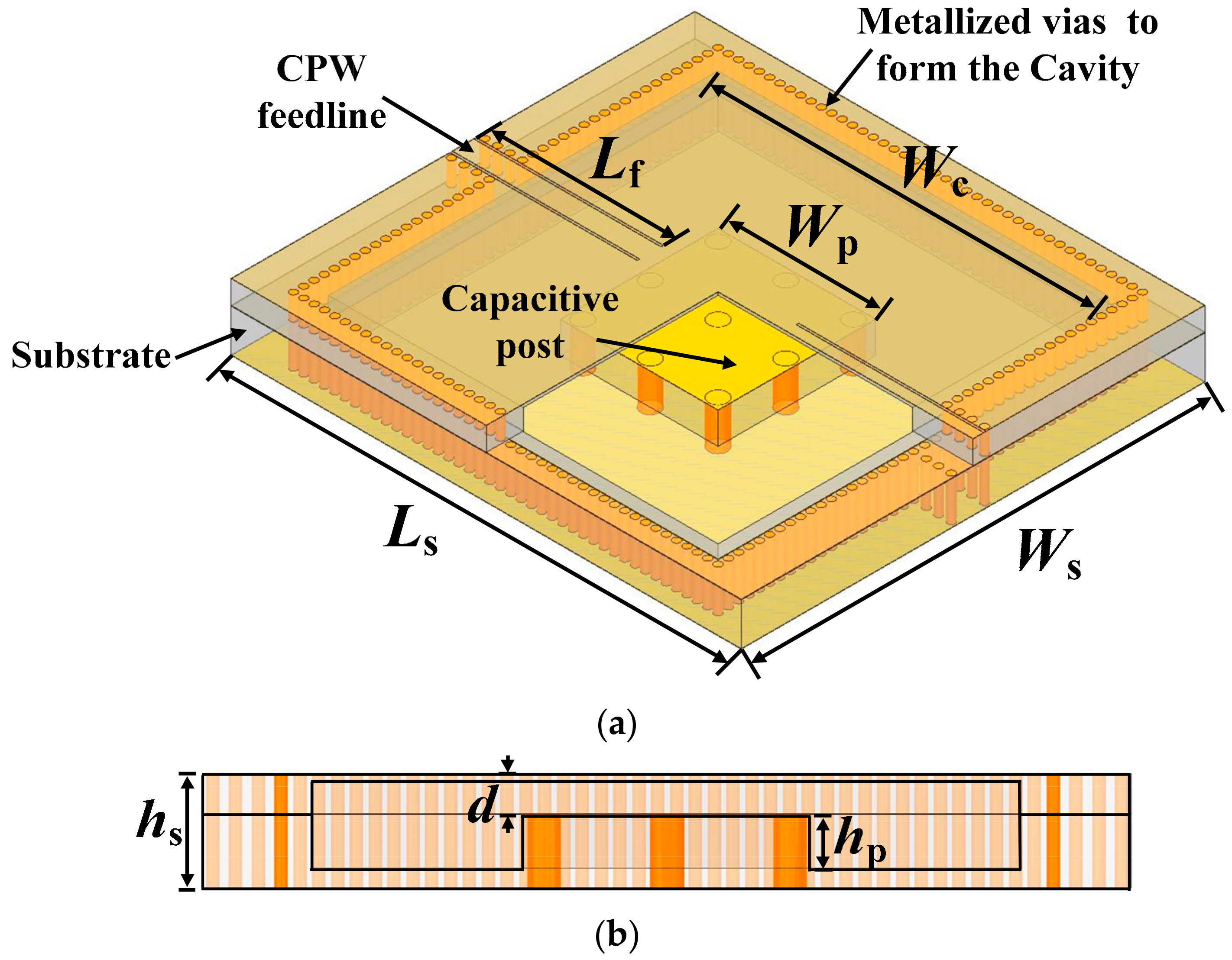
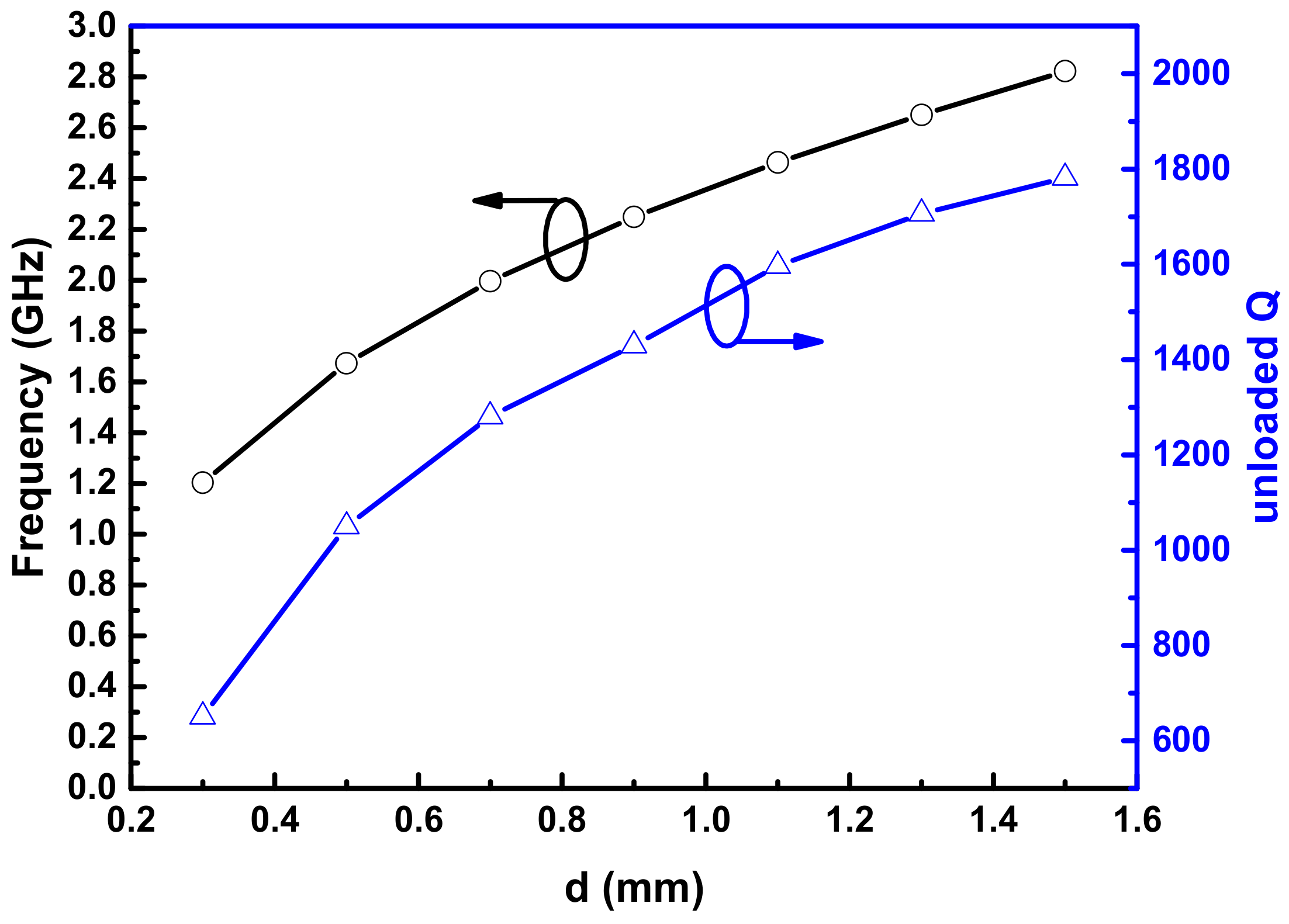
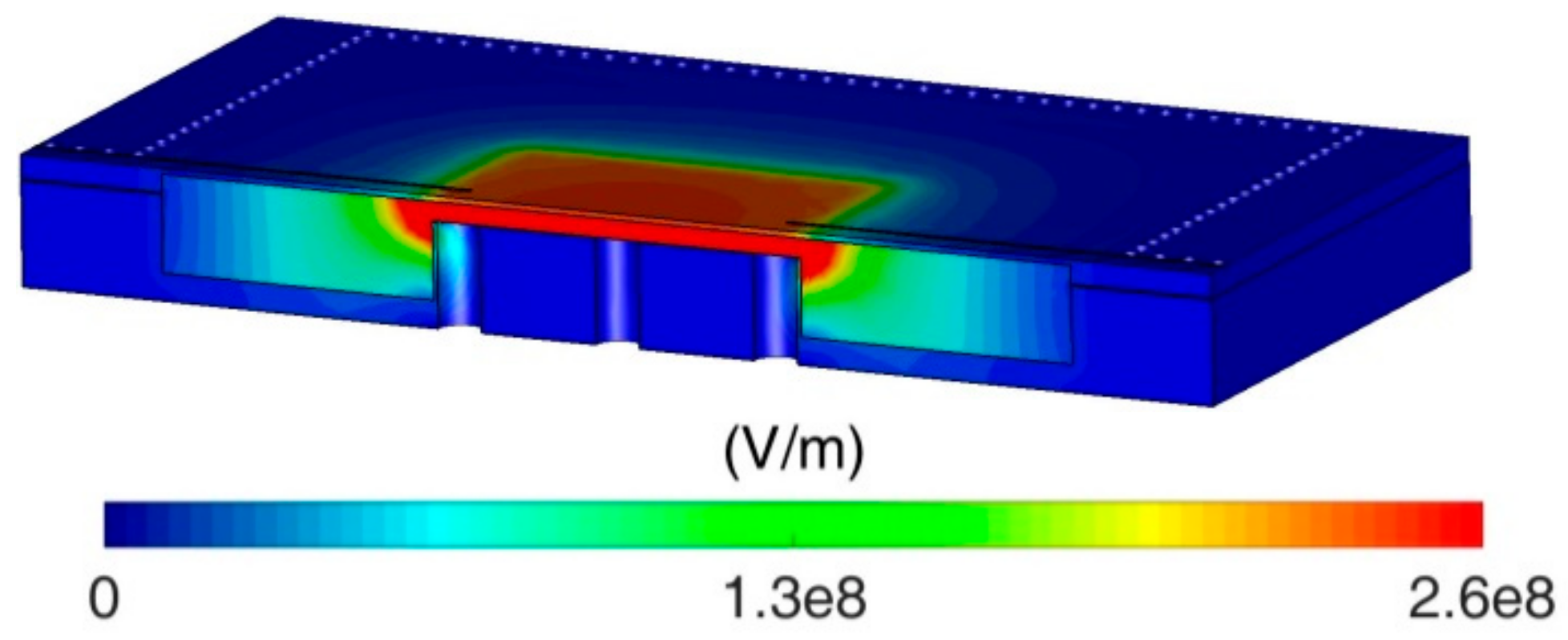
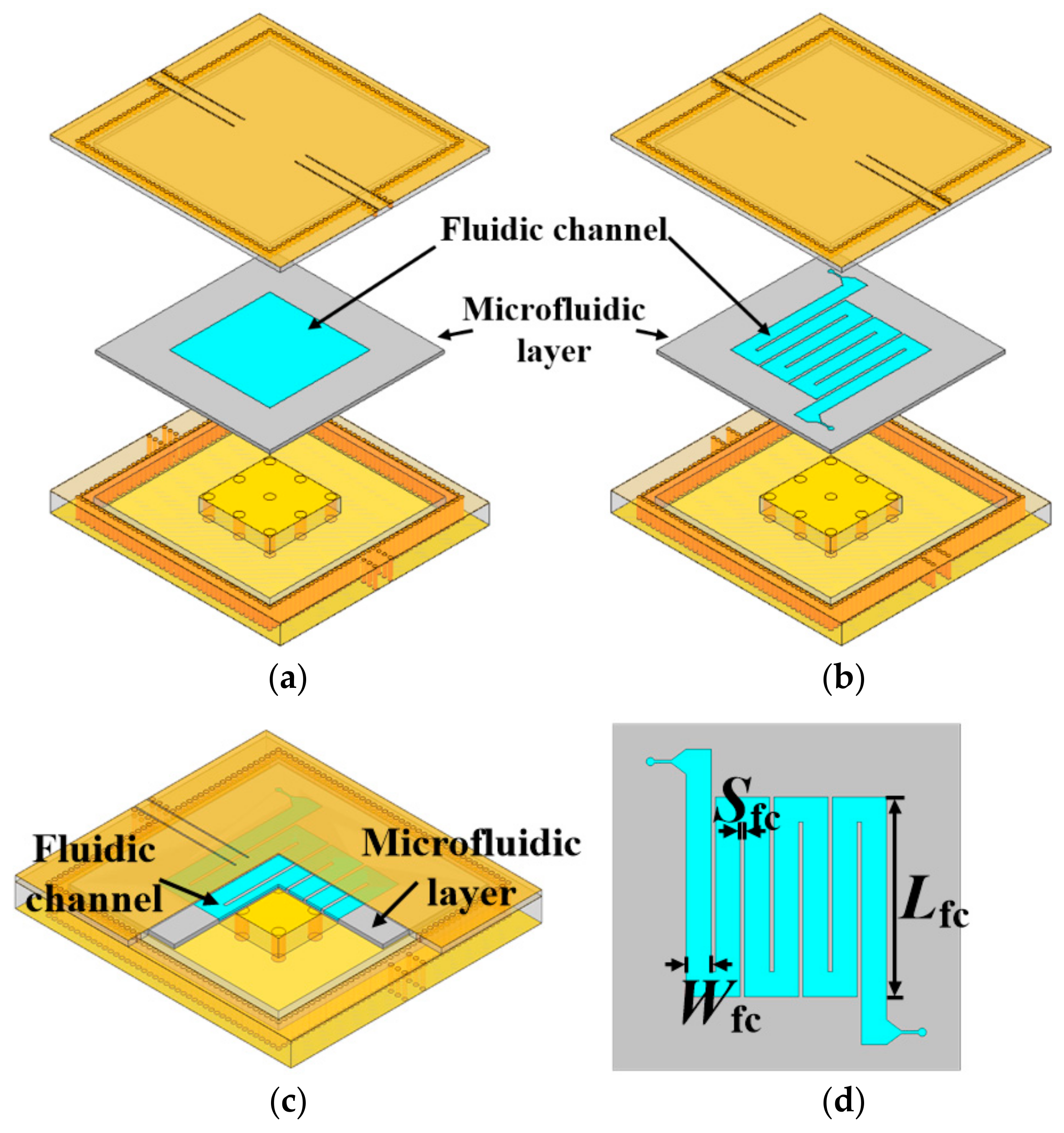
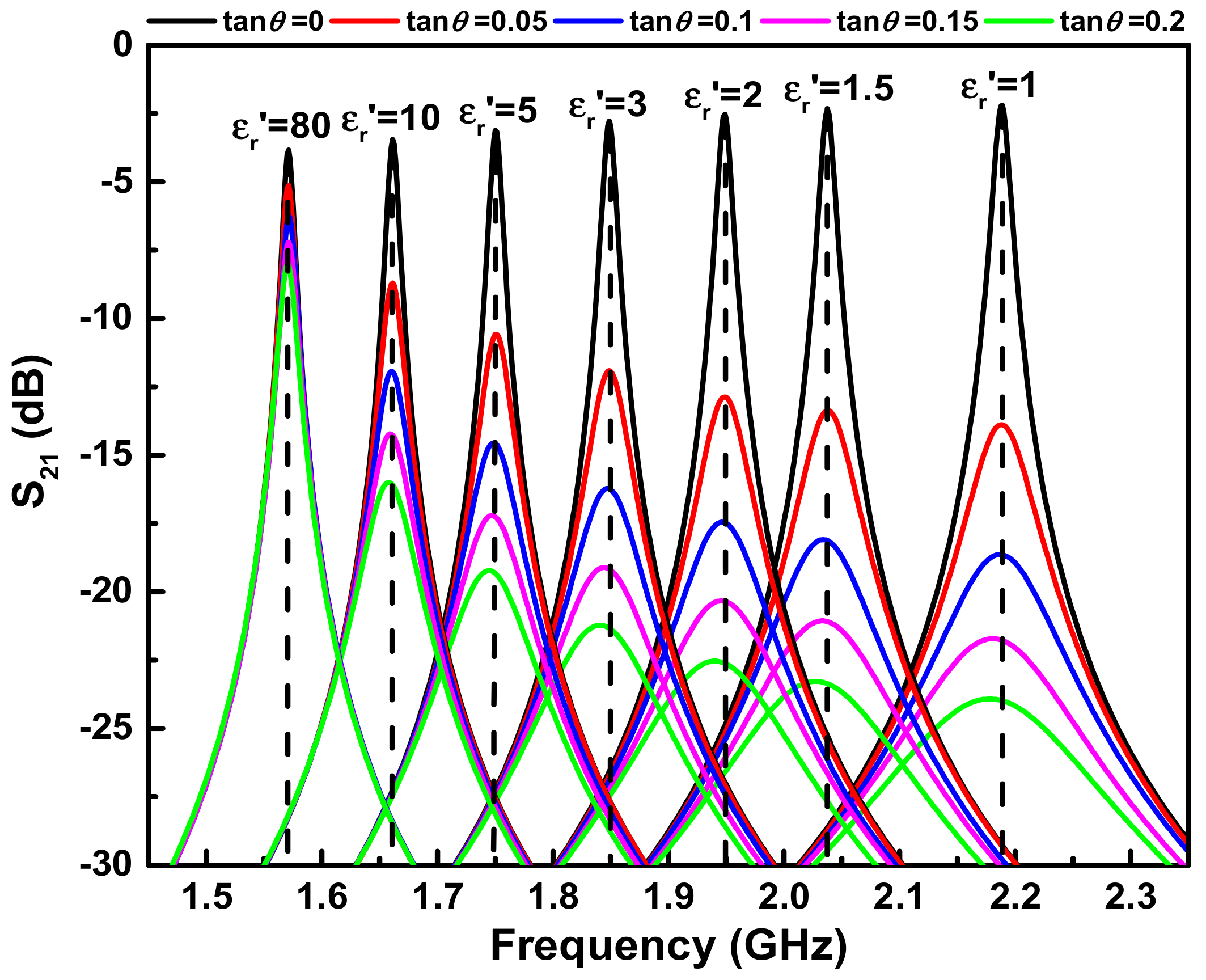
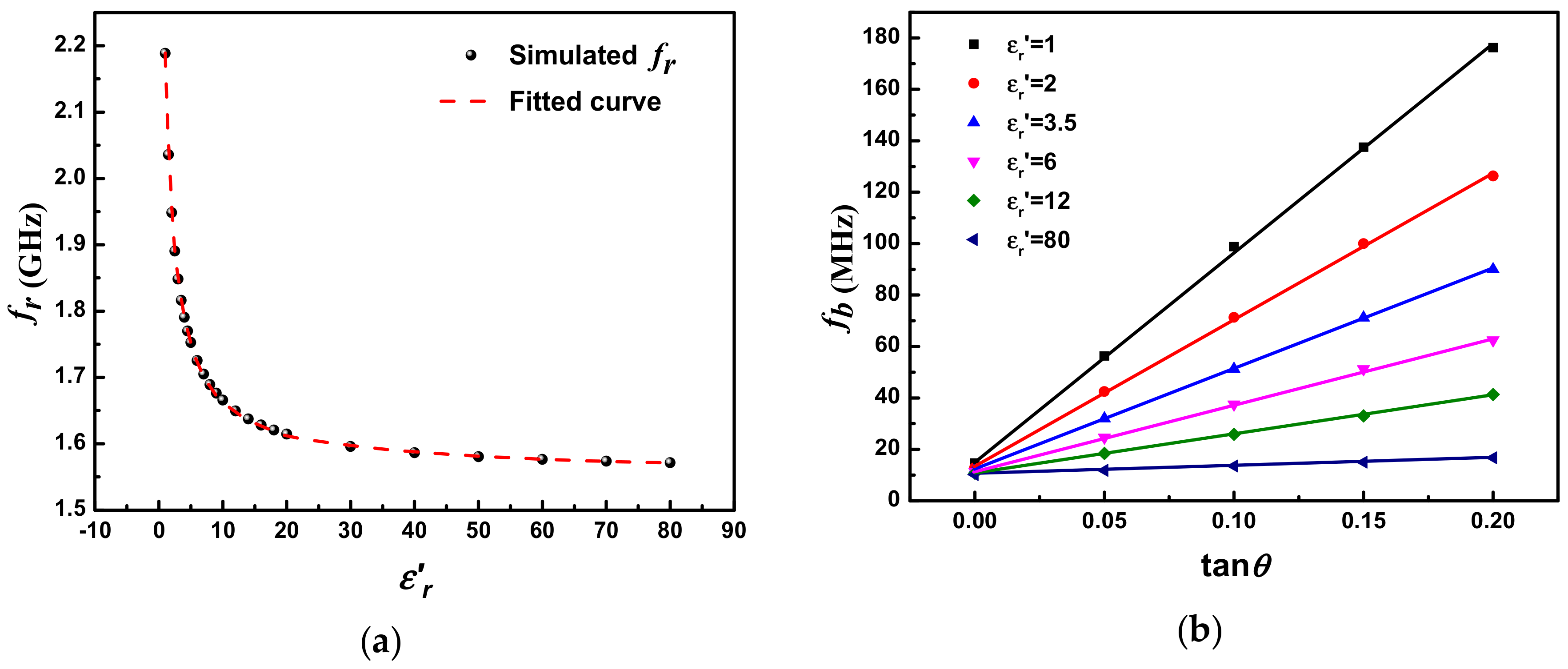

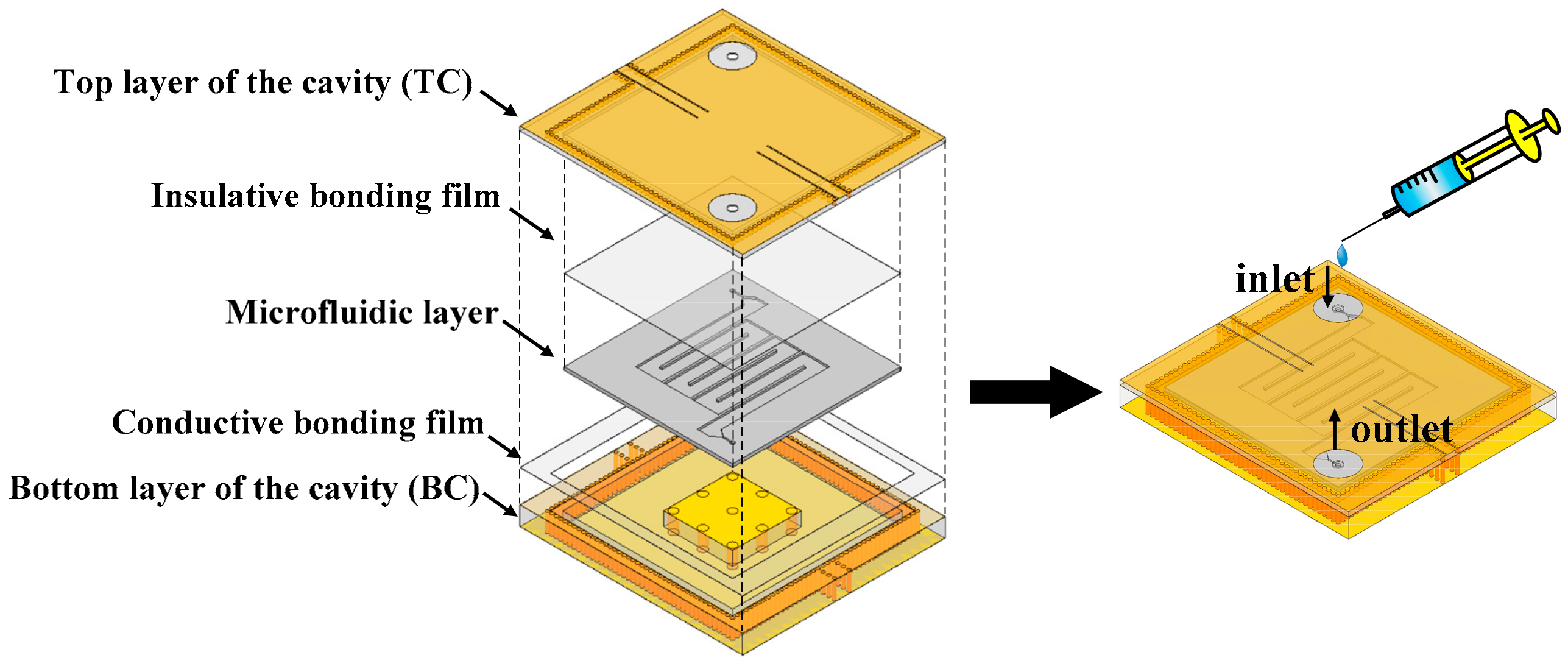

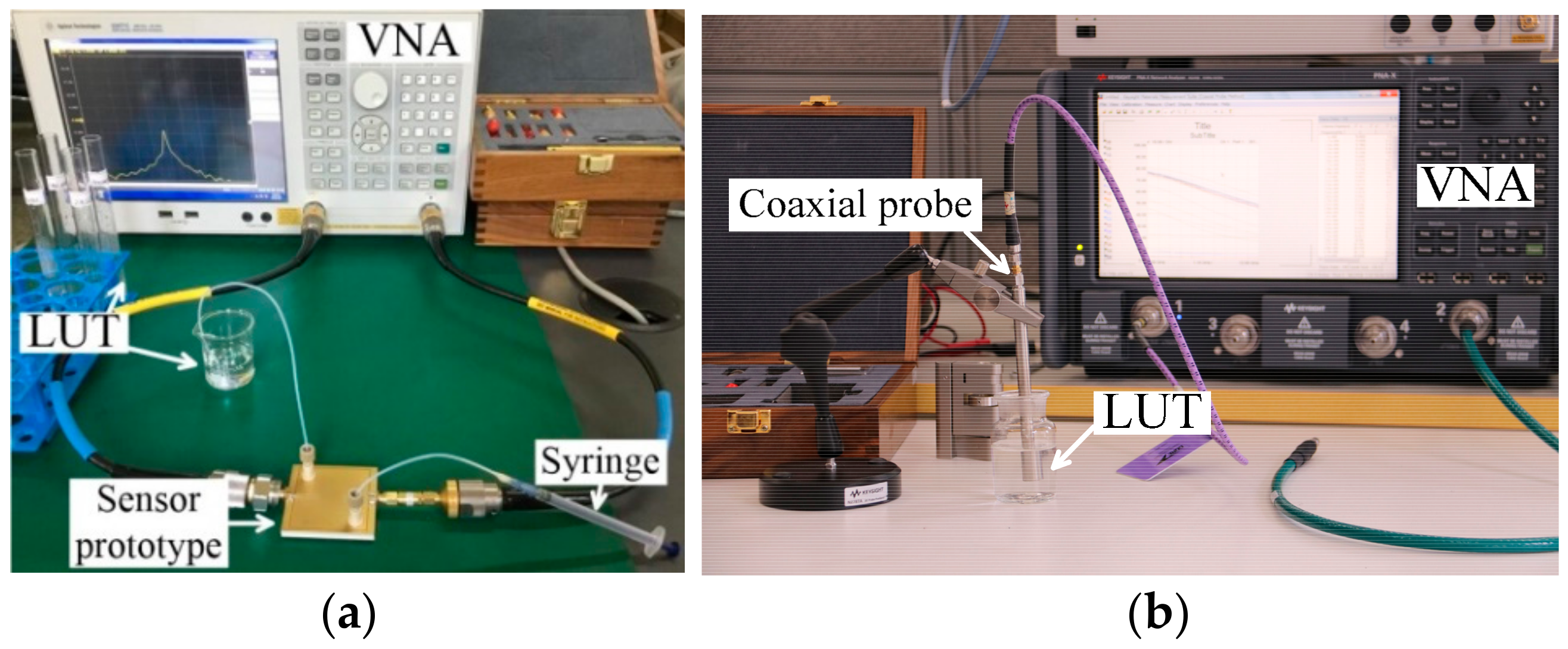

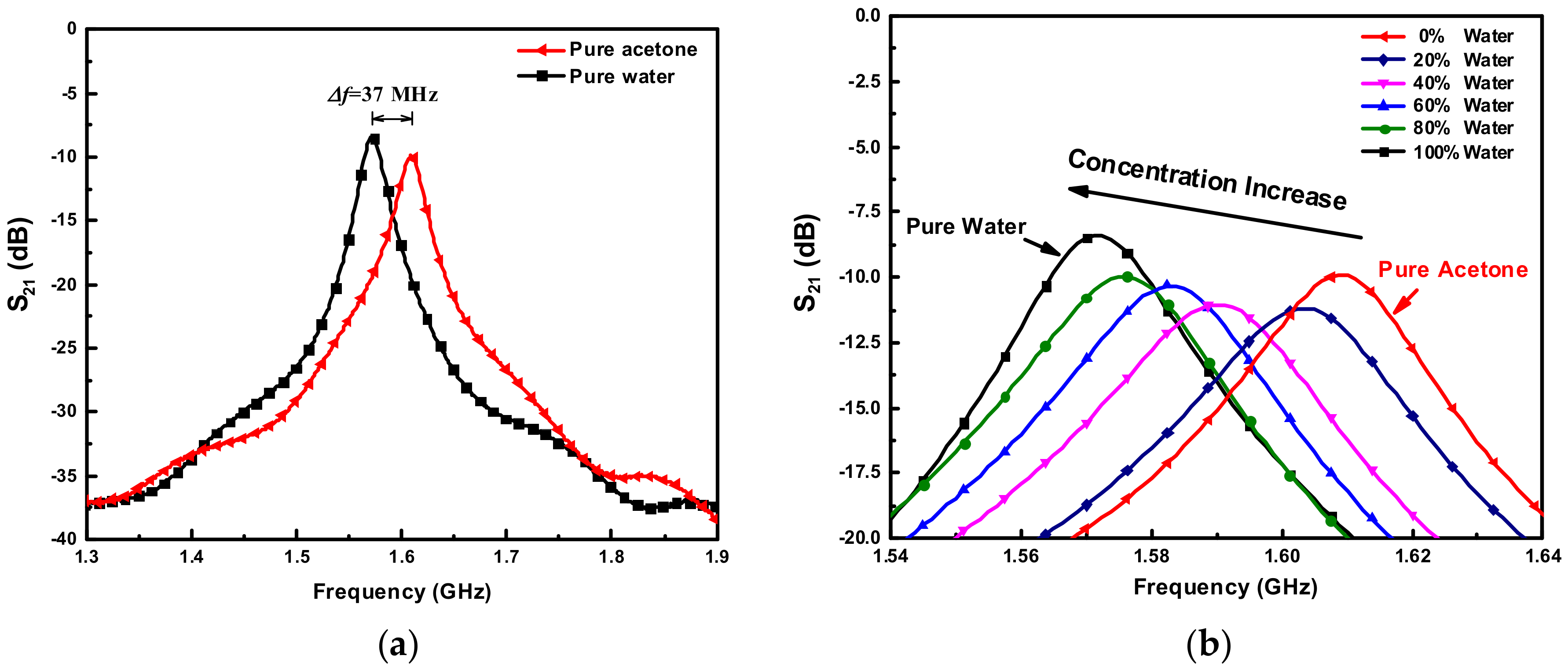


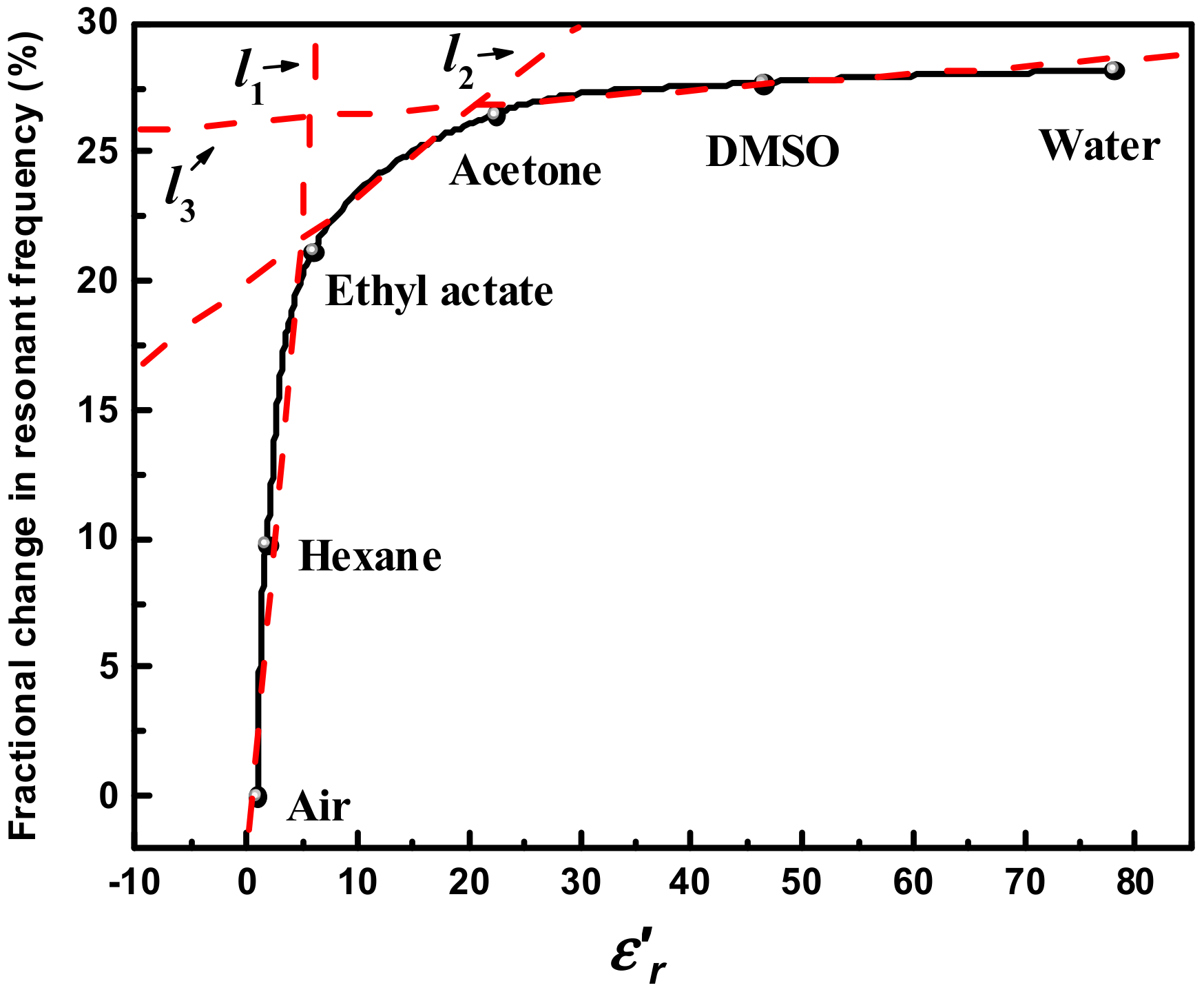
| Parameter | Description | Value (mm) |
|---|---|---|
| Ls | Substrate length | 55 |
| Ws | Substrate width | 50 |
| hs | Substrate height | 5.626 |
| Lf | CPW feedline length | 20.2 |
| Wf | CPW feedline width | 2.31 |
| Wcs | Width of the CPW slots | 0.25 |
| Wc | Cavity width | 42 |
| rvc | Radius of via of the cavity | 0.4 |
| svc | Space between two adjacent vias of the cavity | 1.11 |
| Wp | Capacitive post width | 17 |
| hp | Capacitive post height | 3.372 |
| rvp | Radius of via of the capacitive post | 1 |
| svp | Space between two adjacent vias of the capacitive post | 7.3 |
| d | Gap spacing between the capacitive post and top lid of the cavity | 1.054 |
| Liquid Sample | Simulated fr (GHz) | Measured fr (Averaged) | Simulated fb (MHz) | Measured fb (Averaged) | Measured Complex Permittivity (Keysight Probe) | Theoretical Complex Permittivity [35,36] | Measured Complex Permittivity (Proposed Sensor) | Error (%) |
|---|---|---|---|---|---|---|---|---|
| Air | 2.1888 | 2.18875 | 14.5 | 22.5 | ---- | ---- | ---- | ---- |
| Hexane | 1.9644 | 1.9735 (0.0015) | 13.1 | 19.58 (3.5) | 1.974 − j8.9*10−3 | 1.894 − j3.62*10−4 | 1.8325 − j4.1*10−3 | 3.24 |
| Ethyl acetate | 1.7237 | 1.7254 (0.0023) | 21.25 | 37.29 (4.9) | 6.88 − j0.159 | 5.918 − j0.1758 | 6 − j0.1069 | 1.38 |
| DMSO | 1.5825 | 1.5823 (0.0015) | 20 | 36.3 (5.06) | 43.4 − j8.1 | 45.1 − j7.327 | 46.4 − j4.57 | 2.88 |
| Water | 1.5721 | 1.5715 (0.0005) | 13.5 | 25.62 (3.23) | 79.15 − j6.1 | 77.98 − j5.828 | 79.52 − j6.99 | 1.97 |
| Ref. | Resonator Type | Operating Frequency | Relative Size † | Structure | Measurement Type | Maximum Error | |
|---|---|---|---|---|---|---|---|
| [14] | Cylindrical dielectric resonator | 10.5 GHz | 0.0628 | NA | Non-planar | Non-invasive and contactless | 13.4% |
| [43] | SIW cavity resonator | 8.96 GHz | 0.0188 | (0.46~0.047) § | Planar | Non-invasive and contactless | 2.93% |
| [44] | Complementary SRR-loaded quarter mode SIW resonator | 3.82 GHz | 0.407 | NR | Planar | Non-invasive and contactless | NR |
| [45]-1 | Microstrip SRR | 3.1035 GHz | 0.026 | 0.370.370.016 | Planar | Non-invasive and contactless | 2.3% |
| [45]-2 | 3.1114 GHz | 0.00655 | 2.9% | ||||
| [46] | Coupled impedance resonator | 1.37 GHz | 0.13 | (0.23~0.002) † | Planar | Non-invasive and contactless | NR |
| [47] | Coupled ring resonator | 2.29 GHz | 0.222 | NR | Planar | Non-invasive and contactless | NR |
| [48] | SIW cavity resonator | 17.08 GHz | 0.16 | 1.71.990.147 | Planar | Non-invasive and contactless | NR |
| [49] | SIW cavity resonator | 5.8513 GHz | 0.00683 | 1.460.640.019 | Planar | Invasive | 5% |
| This work | Square SIW re-entrant cavity resonator | 2.18875 GHz | 0.366 | 0.40.360.041 | Planar | Non-invasive and contactless | 3.24% |
© 2018 by the authors. Licensee MDPI, Basel, Switzerland. This article is an open access article distributed under the terms and conditions of the Creative Commons Attribution (CC BY) license (http://creativecommons.org/licenses/by/4.0/).
Share and Cite
Wei, Z.; Huang, J.; Li, J.; Xu, G.; Ju, Z.; Liu, X.; Ni, X. A High-Sensitivity Microfluidic Sensor Based on a Substrate Integrated Waveguide Re-Entrant Cavity for Complex Permittivity Measurement of Liquids. Sensors 2018, 18, 4005. https://doi.org/10.3390/s18114005
Wei Z, Huang J, Li J, Xu G, Ju Z, Liu X, Ni X. A High-Sensitivity Microfluidic Sensor Based on a Substrate Integrated Waveguide Re-Entrant Cavity for Complex Permittivity Measurement of Liquids. Sensors. 2018; 18(11):4005. https://doi.org/10.3390/s18114005
Chicago/Turabian StyleWei, Zhihua, Jie Huang, Jing Li, Guoqing Xu, Zongde Ju, Xuyang Liu, and Xingsheng Ni. 2018. "A High-Sensitivity Microfluidic Sensor Based on a Substrate Integrated Waveguide Re-Entrant Cavity for Complex Permittivity Measurement of Liquids" Sensors 18, no. 11: 4005. https://doi.org/10.3390/s18114005
APA StyleWei, Z., Huang, J., Li, J., Xu, G., Ju, Z., Liu, X., & Ni, X. (2018). A High-Sensitivity Microfluidic Sensor Based on a Substrate Integrated Waveguide Re-Entrant Cavity for Complex Permittivity Measurement of Liquids. Sensors, 18(11), 4005. https://doi.org/10.3390/s18114005



